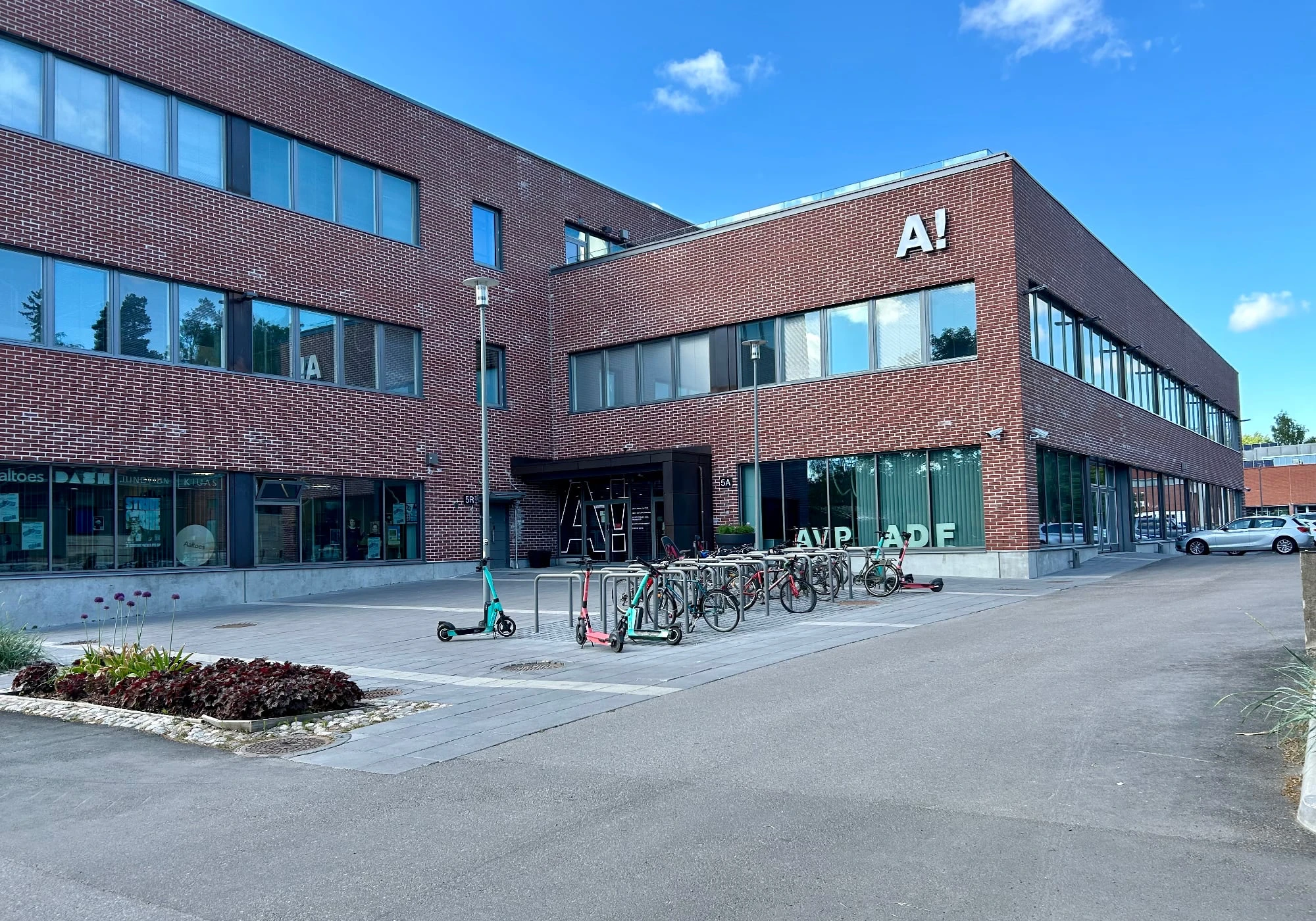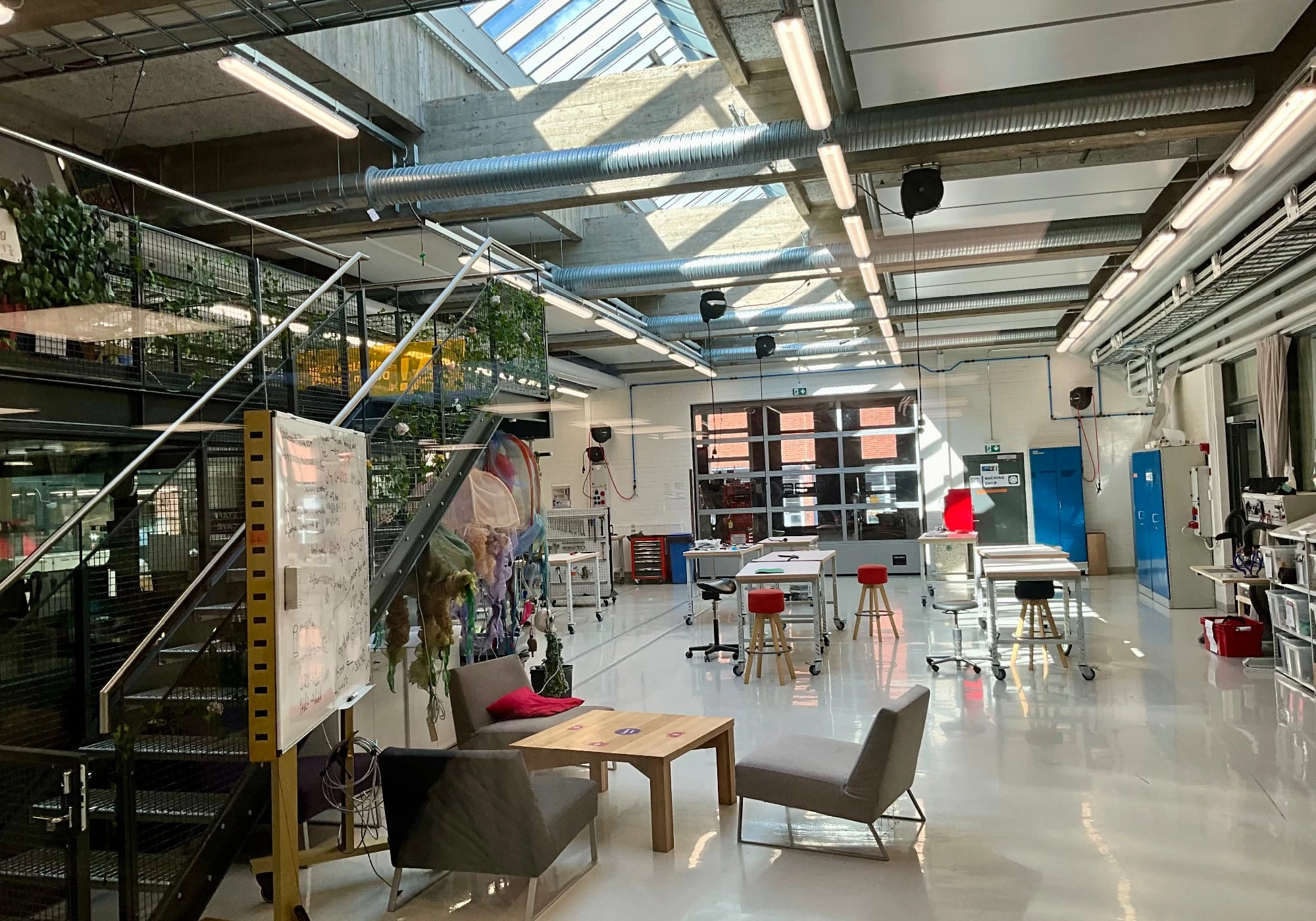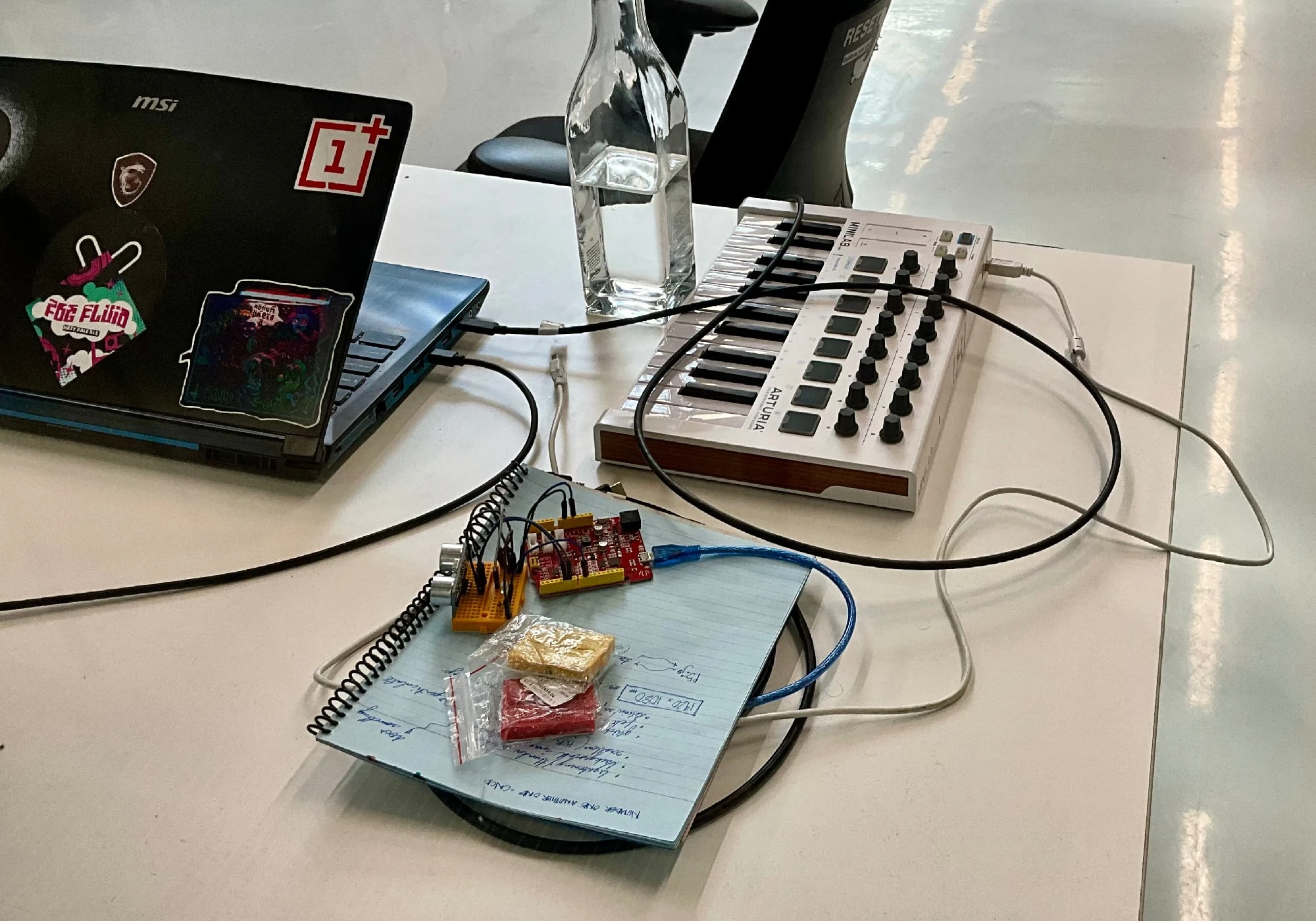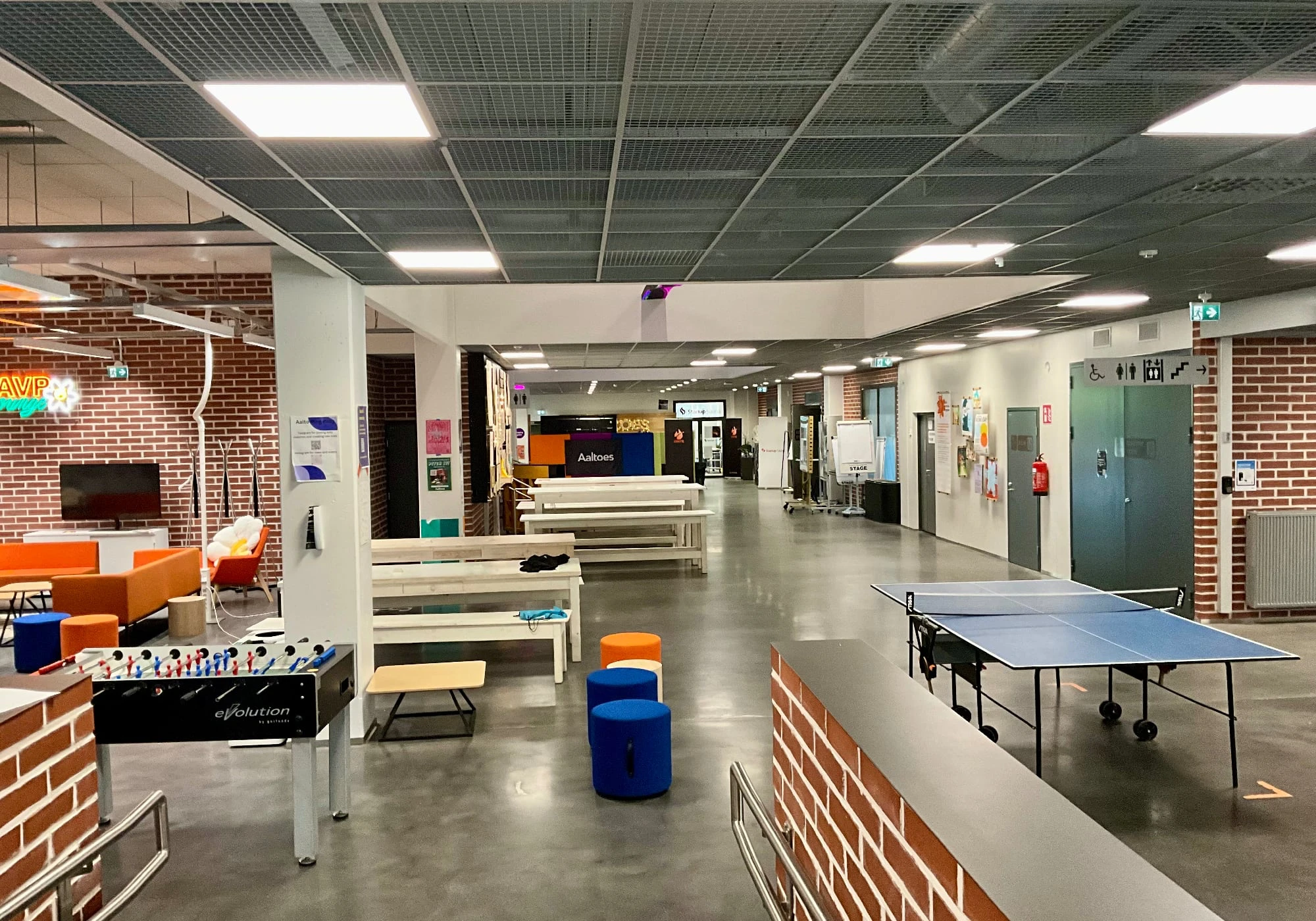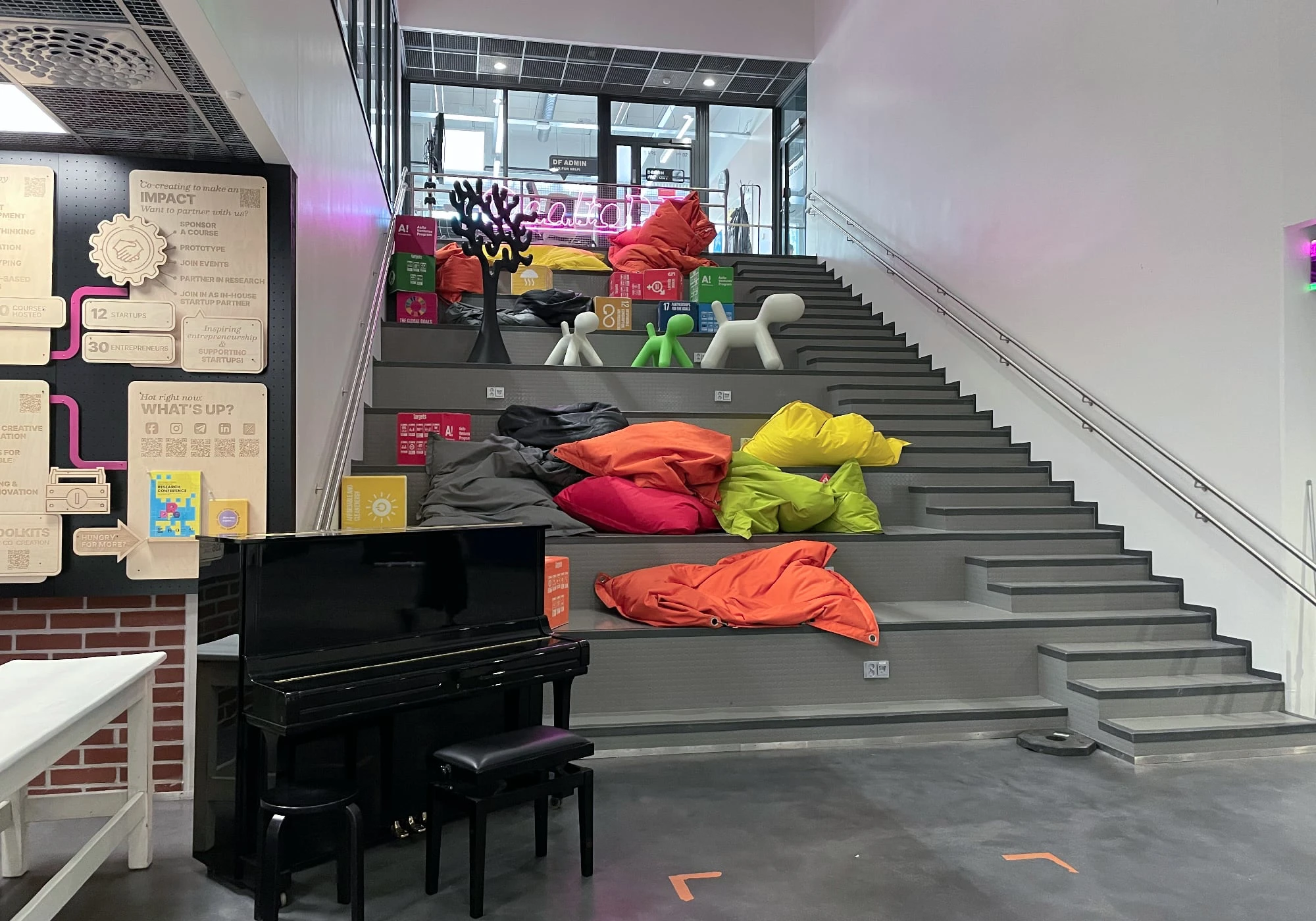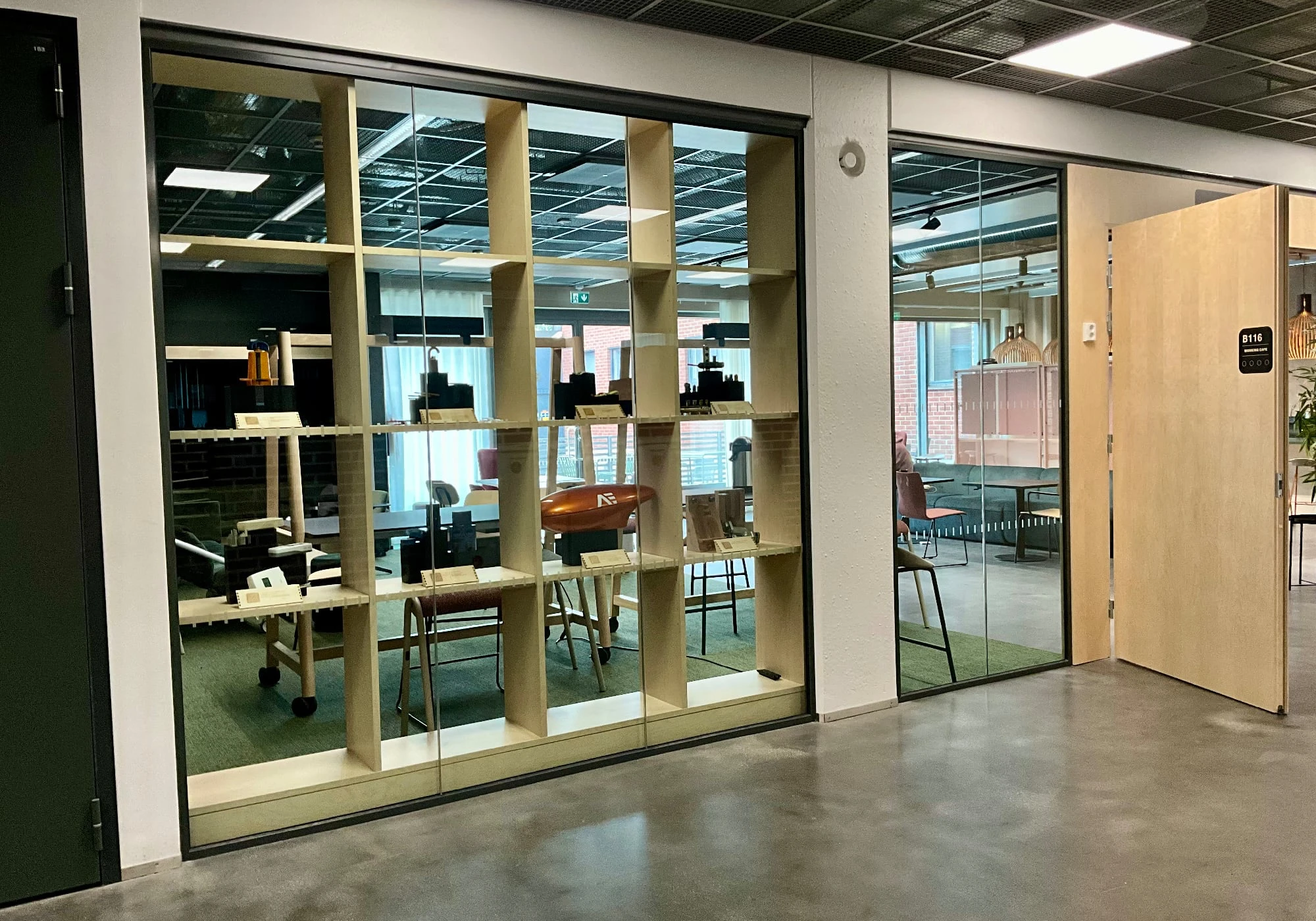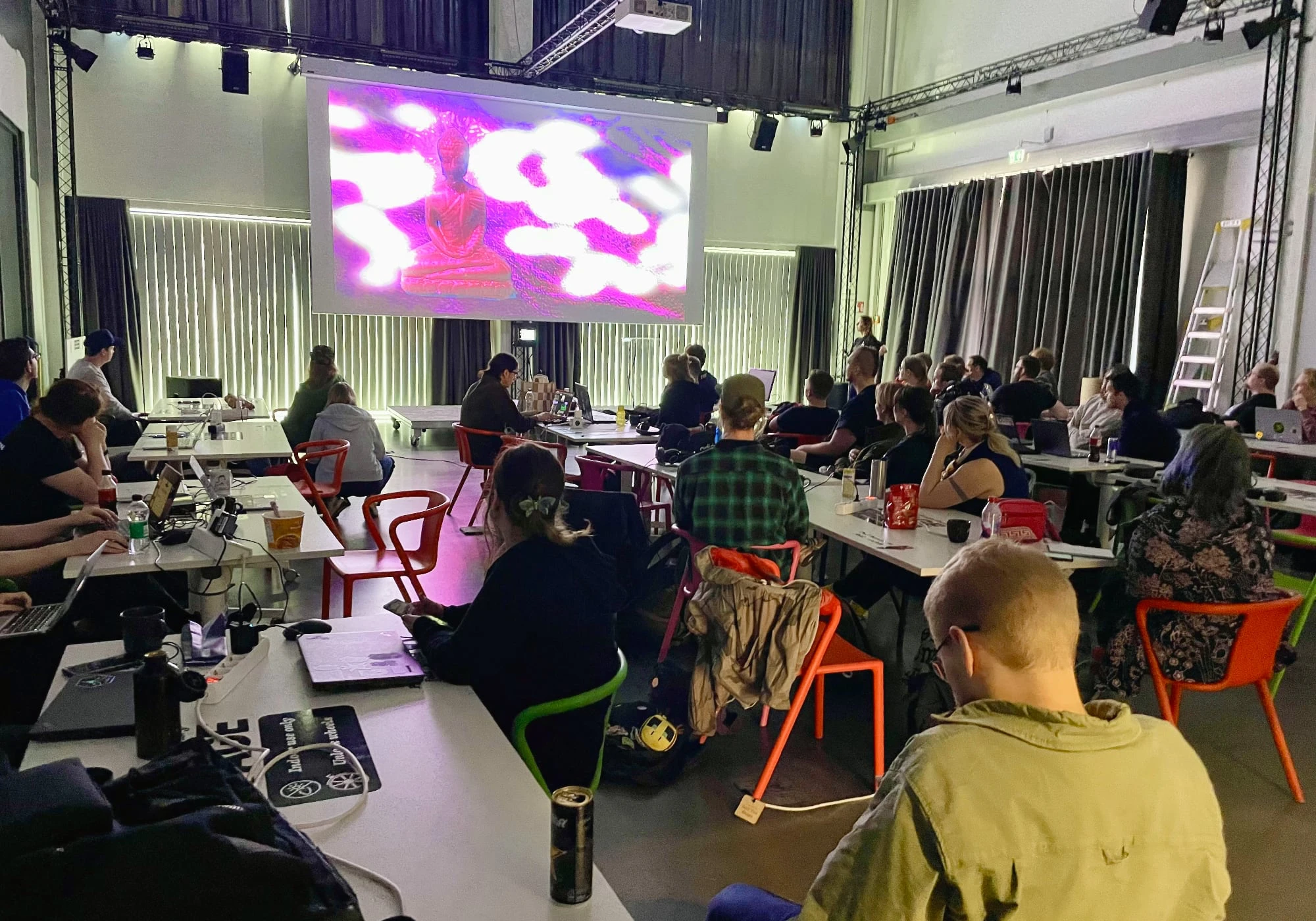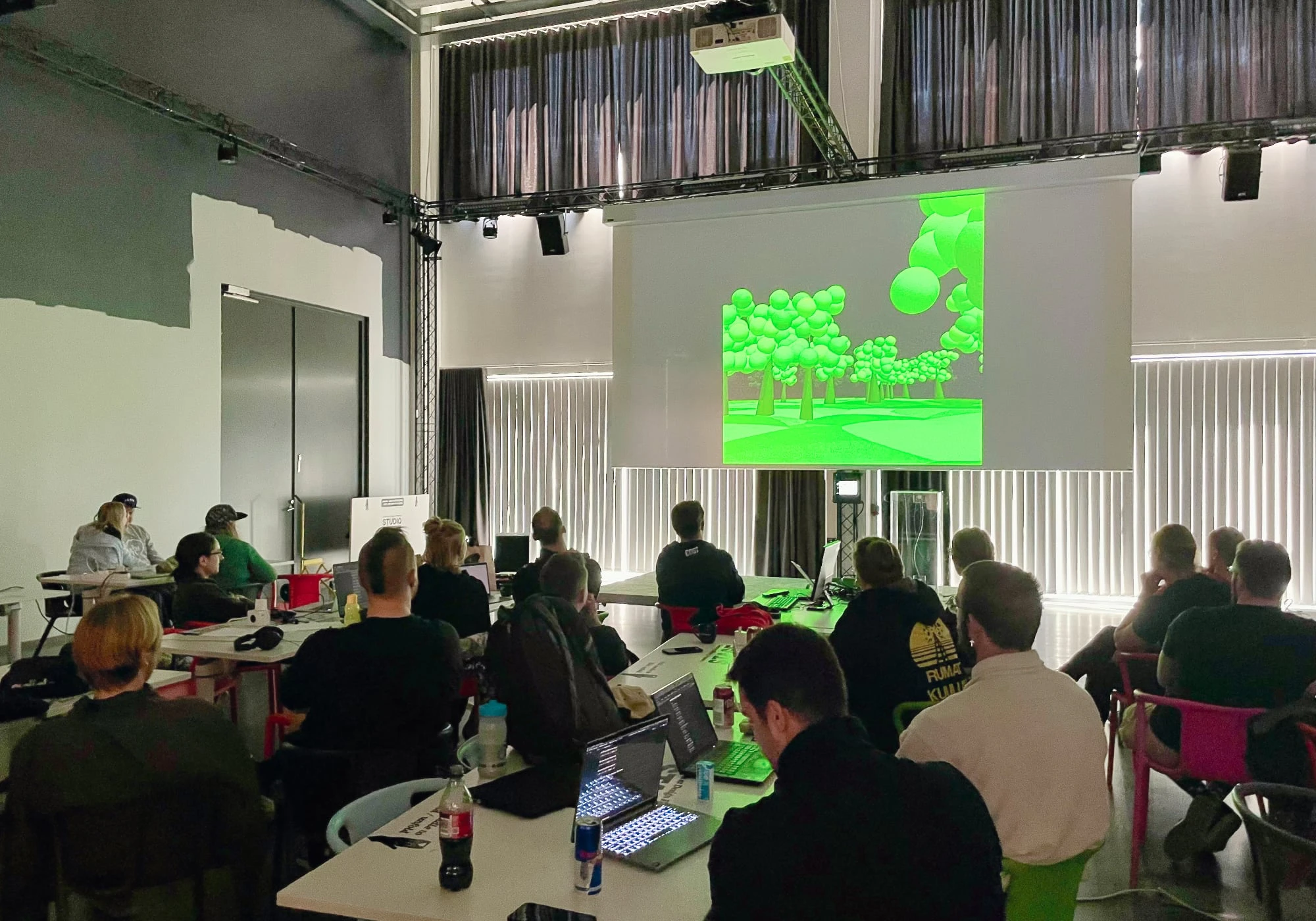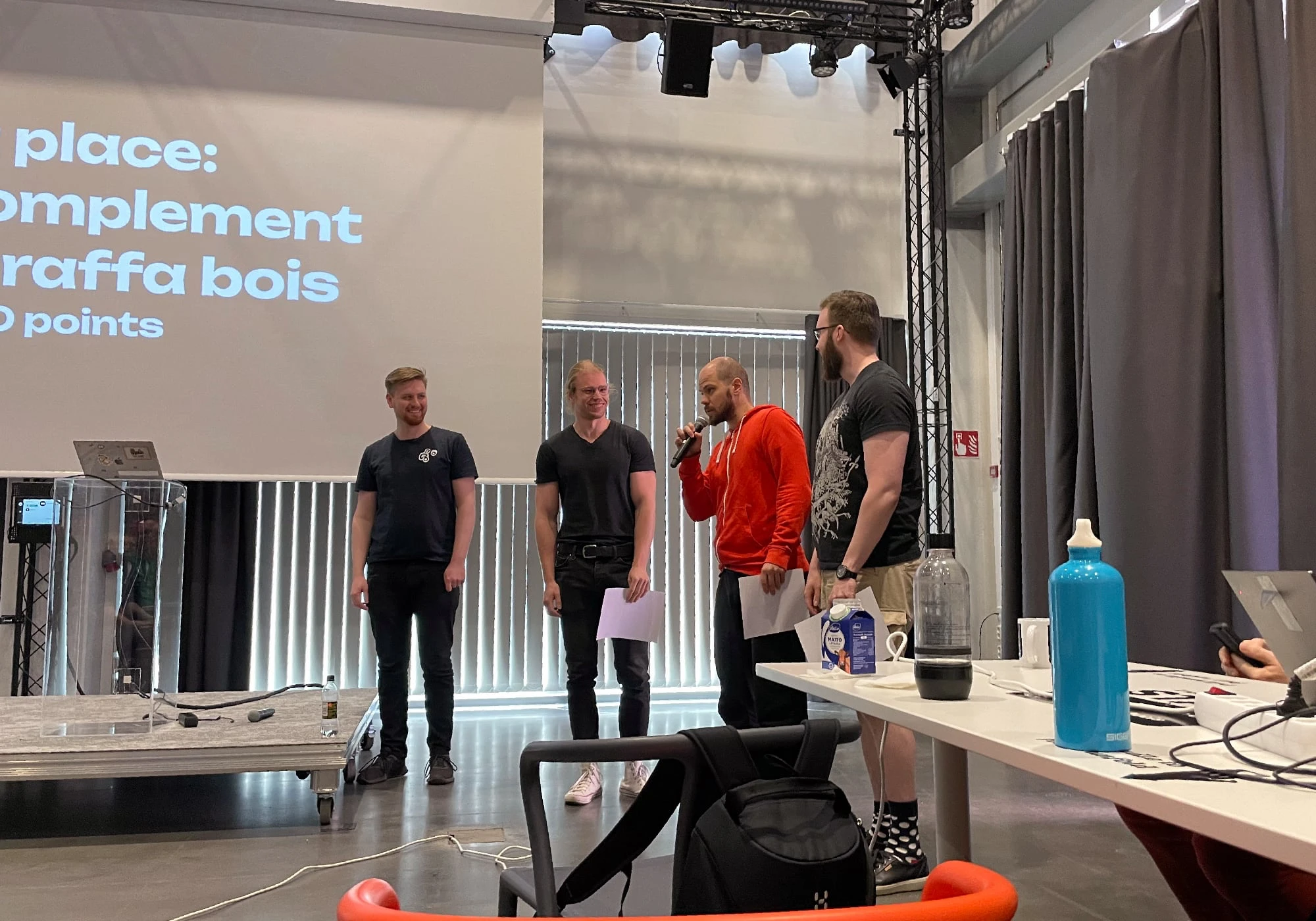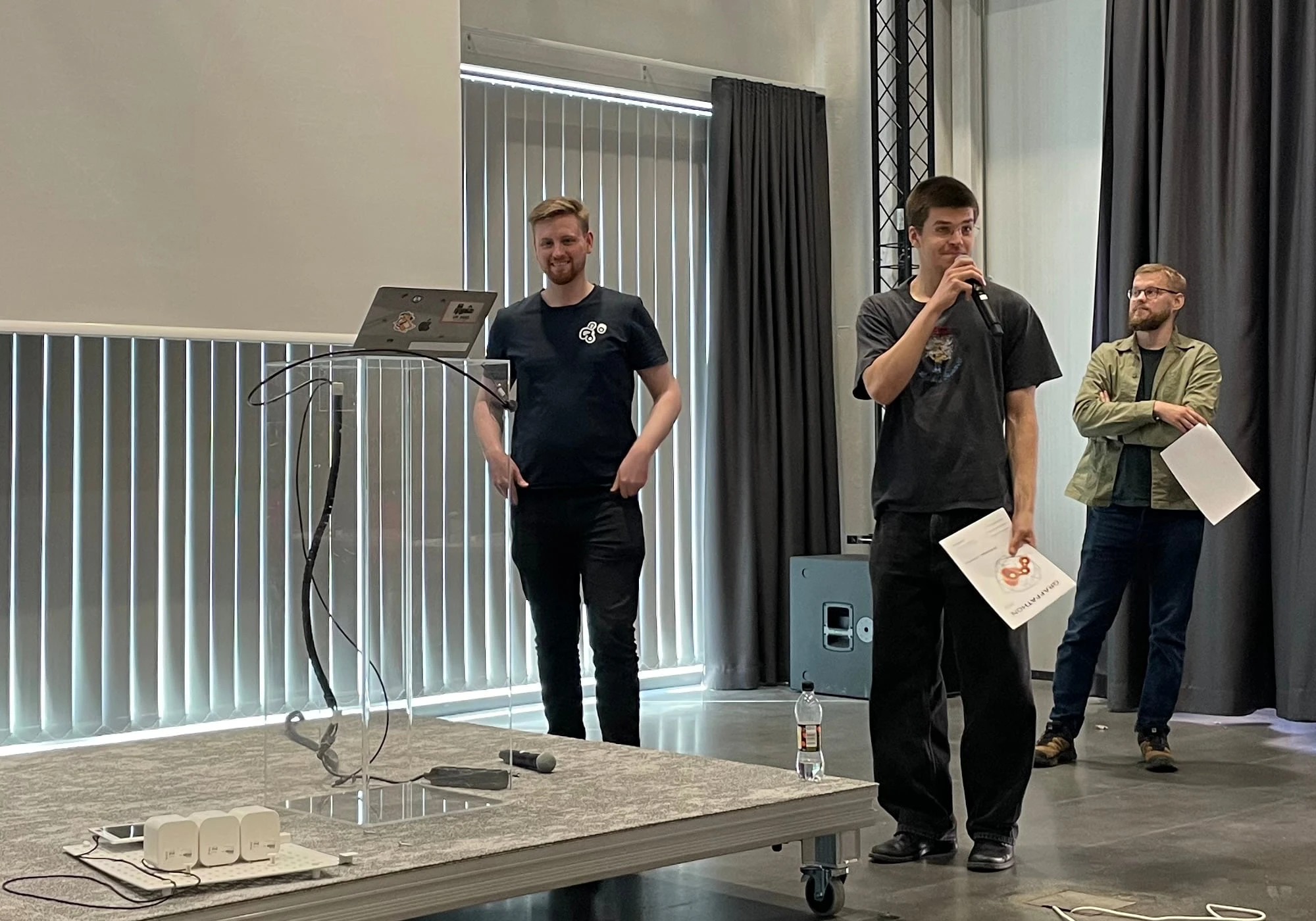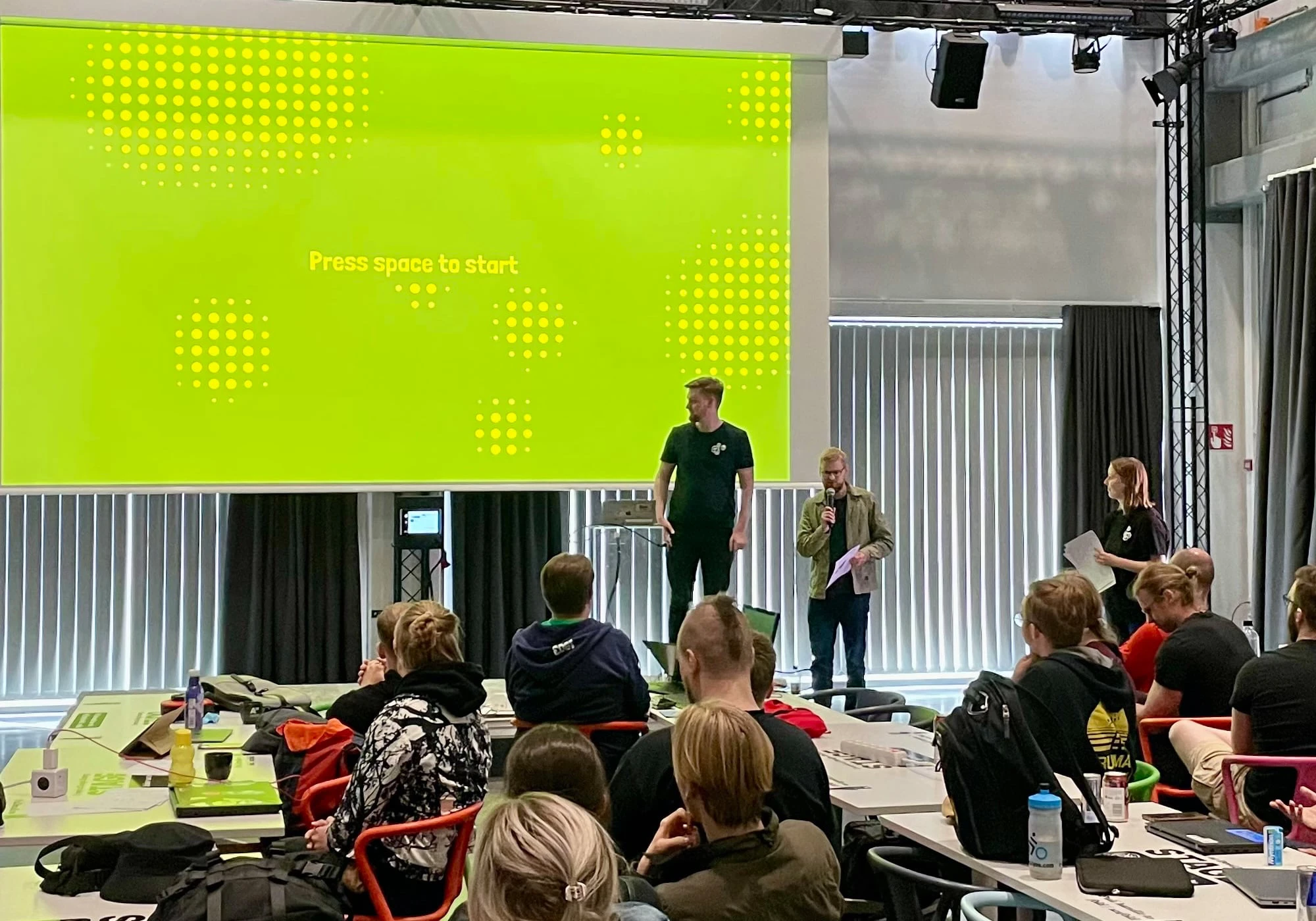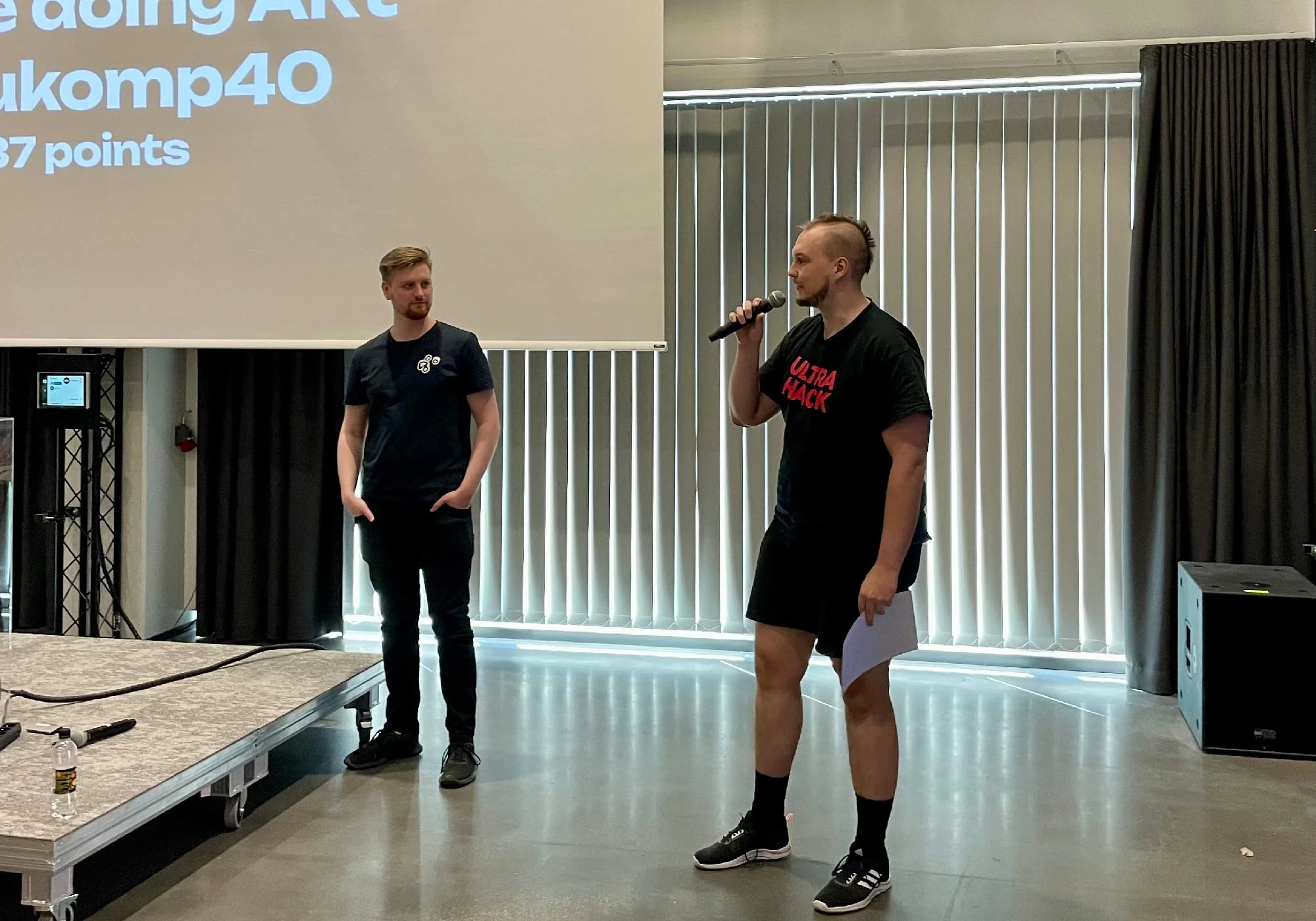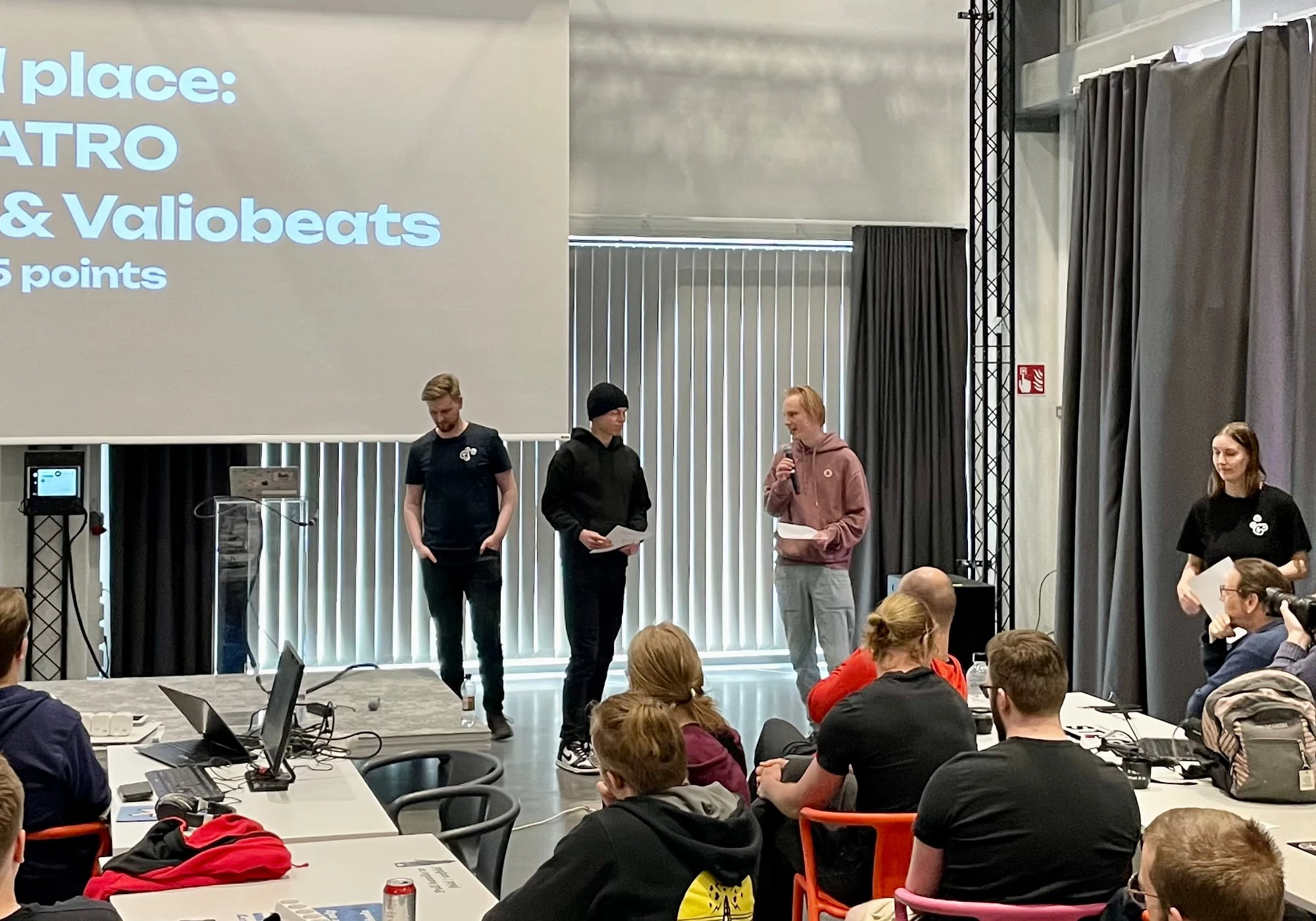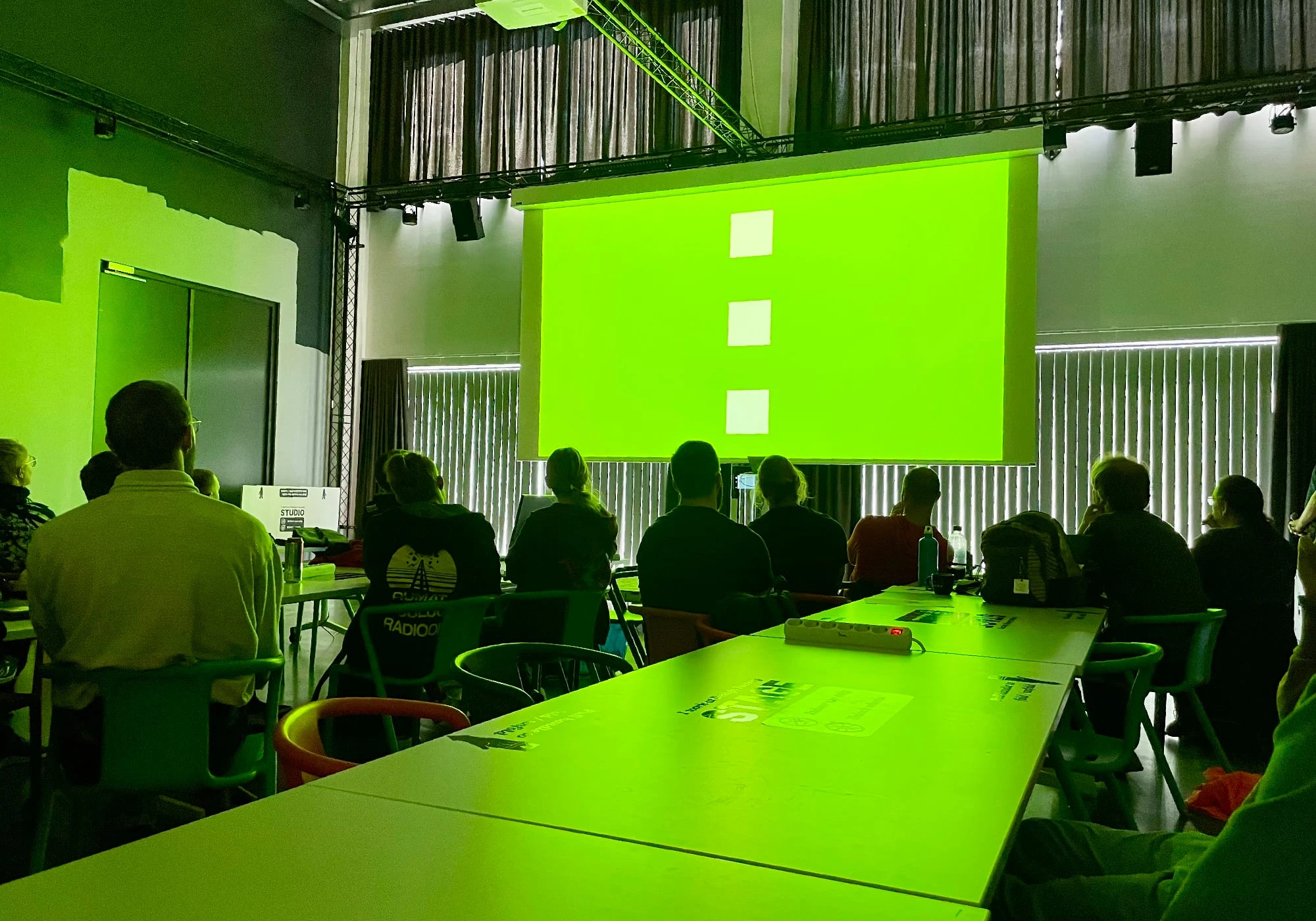Graffathon 2024
Where Coding Meets Art
In June 2024, I attended Graffathon at the Aalto Design Factory in Espoo, Finland. It was an interesting introduction to demoscene culture. Around thirty participants gathered for this uniquely starter-friendly demoparty, enjoying a good helping of creativity and collaboration. Over the course of two and a half days, demosceners crafted seventeen impressive demos, showcasing the talents of both beginners and advanced coders. This article recounts my impressions of Graffathon 2024, exploring the vibrant intersection of art and technology that defines this extraordinary community.
June 2024

Graffathon 2024 was a three day event that provided an
introduction into the demoscene with seventeen entries
submitted for the competition by twenty-eight
participants.
In 2023, I attended two demoparties and three hackathons, one of which was Junction X in Helsinki, Finland. It was my first time in the city. In June of 2024, I returned to Finland for Graffathon 2024, a combined demoscene hackathon and demoparty.
The Graffathon event series is an annual demoscene event held in Espoo, Finland, where university students, enthusiasts and professionals gather to create and showcase digital art, music, and programming demos. Graffathon features a competition allowing participants to demonstrate their skills and creativity. The event provides a collaborative and inspiring environment for the demoscene community to exchange ideas, learn new techniques, and endulge in digital culture.
If you have visited my website before, then you probably know what the demoscene is. For the sake of completeness, I will nevertheless describe it here: The demoscene is a global computer art subculture focused on creating and sharing real-time audiovisual presentations, known as demos. These demos are intricate combinations of programming, graphics, music, and design, often pushing the limits of computer hardware and software. They are usually not interactive but in most cases rendered in real-time. Originating in the 1980s with the advent of home computers, the demoscene emphasizes creativity, technical skill, and innovation. Participants, known as sceners, often compete at events called demoparties, showcasing their work and exchanging ideas in a collaborative and competitive environment.
Finland has a long demoscene tradition. There is even an exhaustive series of documentaries about the Finnish scene. One of the largest events held in the country is Assembly, a combined gaming party and demoparty. Of course purists are keen to point out that while Assembly is the largest event on the whole, it is not exclusively dedicated to the demoscene because it has a large gaming component to it. The honour of being the largest demoparty goes to Revision in Saarbrücken, Germany.
Visiting any large demoparty can be overwhelming and confusing. The demoscene has a long and storied history with a multitude of different computer systems, traditions and techniques. This is where Graffathon comes in. It is an introductory event for participants from the computer sciences and also from the media arts. It is a much more mellow and relaxed event than the loud and in-your-face demoparties elsewhere. The organizers provide tutoring and guidance on how to create a demo and describe the history of the demoscene.
Graffathon is also different than many other demoparties in another way. I have the impression that most of the participants at some of the established parties like Revision and Evoke tend to be middle-aged dudes. Here at Graffathon, the audience skews younger and more mixed.
A few days before the event, I got the invitation link to the Graffathon's Telegram channel. The organizers made their announcements there, provided links and current infos. Most importantly, throughout the event, people would write on Telegram asking someone to open the door to the Design Factory, so that they can enter the venue's premises.
Graffathon was the fourth demoparty I've attended in person. And I liked it a lot! Let's look at it in more detail.
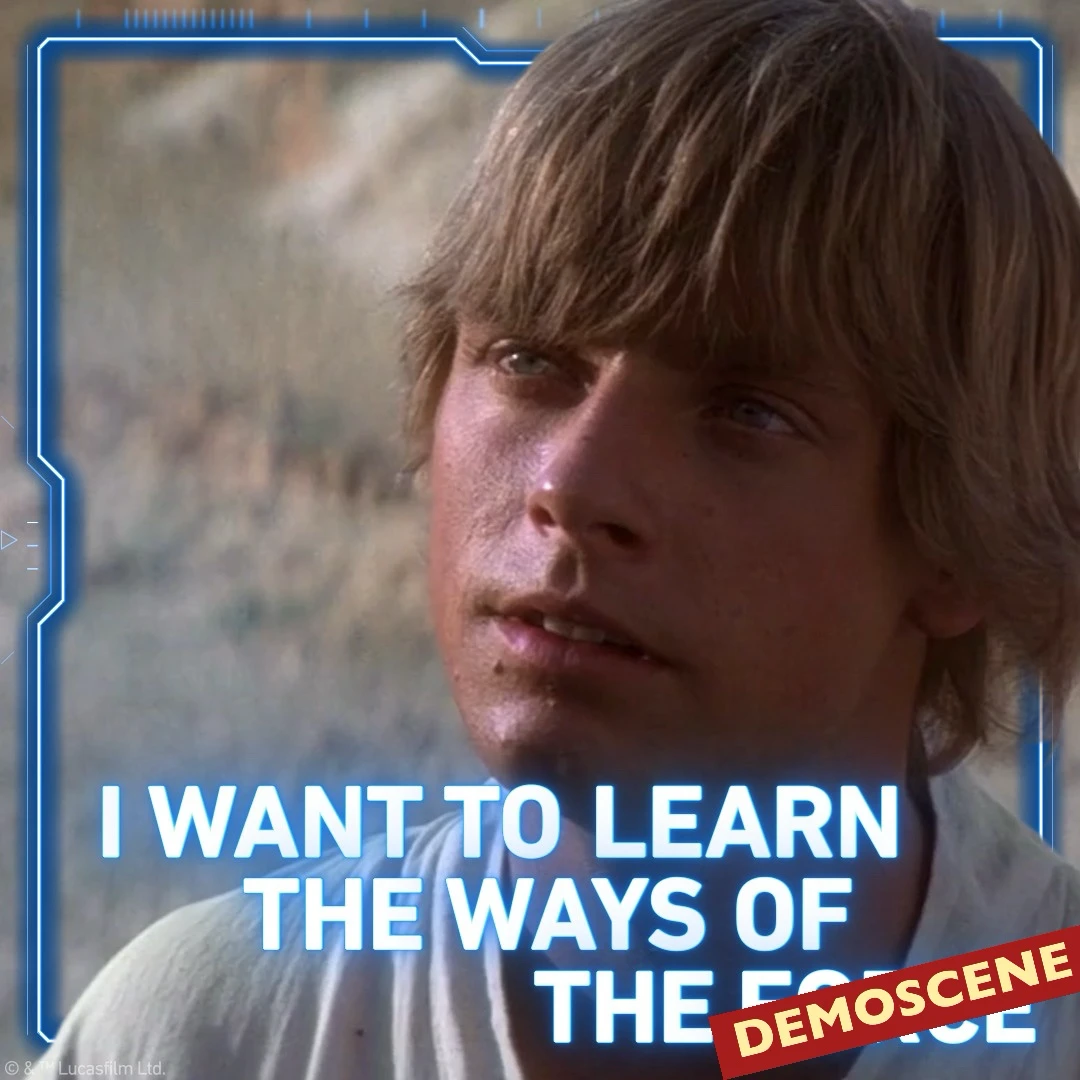
Graffathon 2024 Schedule
The Graffathon series of demoparties began in 2014. Had it not been for the COVID-19 pandemic, which caused cancellations from 2020 to 2022, Graffathon would have celebrated its tenth demoparty in 2024.
Despite these disruptions, the series maintained its relevance and visibility through several channels. Like this year, each of the previous events was announced on demoparty.net, a key platform for the demoscene community, ensuring participants were well-informed in advance.
After each event, the results were meticulously archived on demozoo.org and pouet.net, preserving the creative output and making it accessible for future reference. This extensive archival process contributed to a significant digital footprint for the Graffathon series.
An last but least, the regular demoscene reports by PS, a notable figure in the scene, along with announcements on the demoscene Discord, ensured that Graffathon received widespread attention within the community.
Despite the inactivity of their official website, graffathon.fi, the robust archival and promotional activities kept the spirit and legacy of Graffathon alive, due to the resilience and interconnectedness of the enthusiast in the demoscene community.
Instead of using their original website, the event schedule was up on Eventbrite. This also served as the ticket booking platform (free of charge).
Here's a quote from the Graffathon Eventbrite page:
"Participants make an audiovisual artwork by programming or some other method that brings computational art vibes. The entries are typically 1-2 minutes long and they are watched together from the big screen on Sunday. Each artwork gets points from the audience and best teams in both categories (beginner, advanced) win tickets to Assembly computer festival. However, the main point of Graffathon is to learn and create together!"
I'm not sure how long Eventbrite will keep the old event page live, so here below is the verbatim schedule for posterity.
Friday, June 7, 2024
| Time | Event |
|---|---|
| 17:00 | Doors Open |
| 18:00 - 18:30 |
Opening Ceremony Welcome + practicalities of the event. |
| 18:30 - 19:30 |
Keynote: "Why is Demoscene?" by Urs Inspirational intro to the history and essence of demoscene. |
| 19:30 - 20:00 |
Getting Started With Demo Tools by Felix Our material is available online during and after the event. This slot is for a quick intro and room for any questions. |
| 19:30 - 23:00 | Making the Demo |
| 23:00 |
Doors Close for the Day You may leave earlier than 23:00 if you want. |
Saturday, June 8, 2024
| Time | Event |
|---|---|
| 09:00 | Doors Open |
| 09:00 - 23:00 | Making the Demo |
| 23:00 |
Doors Close for the Day You may come later, leave earlier or work on the demo at home. Just communicate with your team, if you have one. |
Sunday, June 9, 2024
| Time | Event |
|---|---|
| 09:00 | Doors Open |
| 09:00 - 14:00 | Making the Demo |
| 14:00 |
Submission Deadline Organizers need about an hour to verify that all demos are working. Please be available during this time window on a quick notice, unless you have verified your demo earlier with the organizers. |
| 15:00 - 17:00 |
Demo Compos We will watch the demos from the big screen. There are two categories: advanced and beginner. The audience will give points to each demo and winners will be awarded. |
| 17:00 - 18:00 |
Awards + Closing Ceremony What about life after Graffathon? There are many other events and activities to take part in. |
| 18:00 - 19:00 | Clean Up & See you next year! ❤️ |
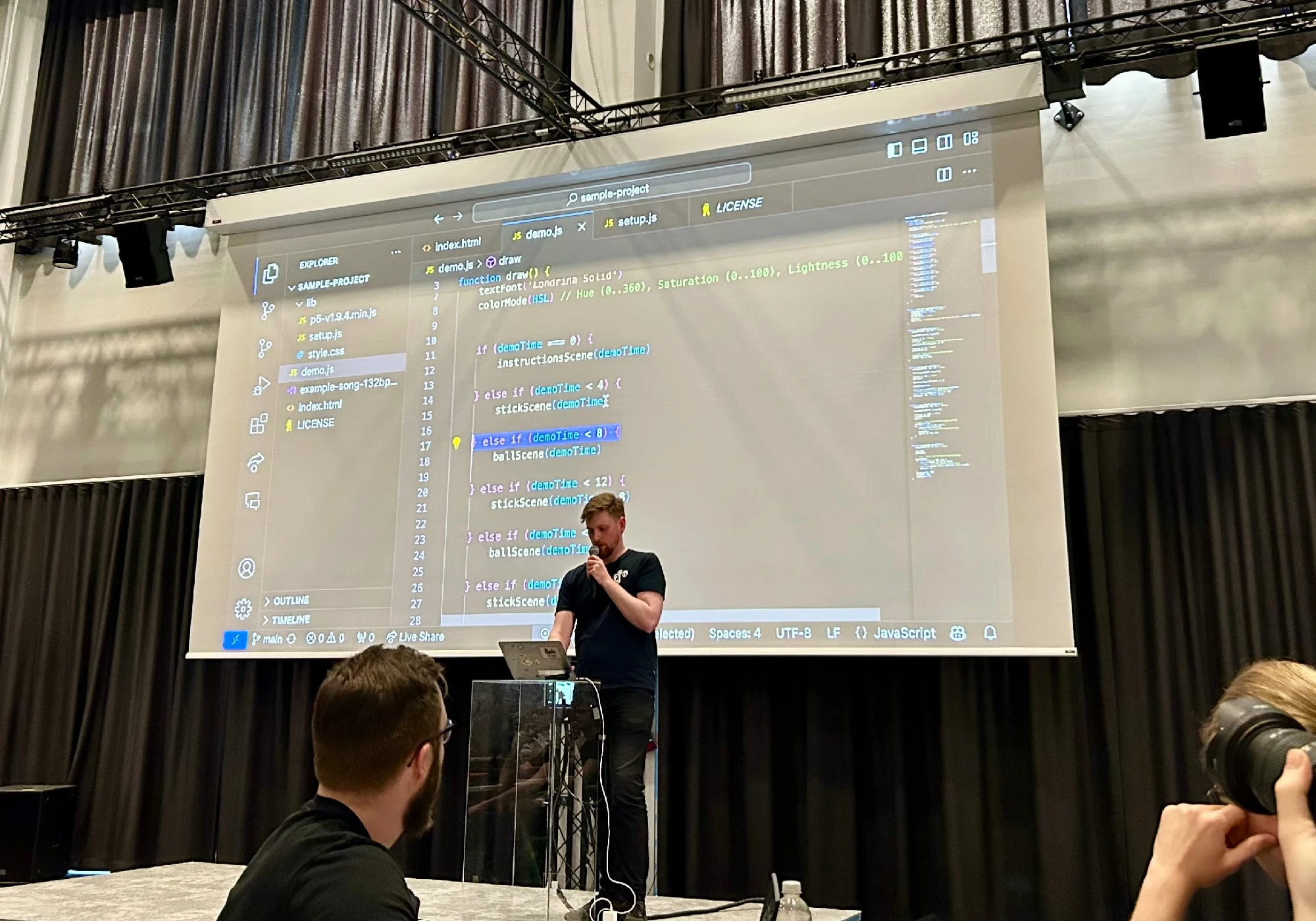
The event's schedule, rules and coding examples presented by
Felix.
First Day: Preludes and Introductions
I arrived in Helsinki just in time to go to Espoo, the neighboring city. To be fair, it is connected by the metro and, like Dorothy in "The Wizard of Oz," I didn't even notice that I was no longer in Helsinki. I found my way to the delightful Aalto University campus with all of its clean buildings and slightly more rural appearance compared to Helsinki. The Aalto Design Factory was easy enough to find, and I realized that I had been here before. On the very first day of Junction X, we came to the "Startup Sauna" in the Aalto Design Factory for an event introduction (see my Junction X hackathon report).
This time, I was here for Graffathon 2024, and I couldn't wait. The doors opened at 17:00. I entered together with the other participants. Most of the folks here were university students. Despite the majority being from Finland, there were some participants from abroad. They all had in common their eagerness to start their journey into the world of the demoscene. The organizers and tutors were also university students, studying subjects related to computer science or media arts.
At 18:00, the event officially began with a welcoming address by Felix Bade from the organization team. He gave us an overview of the practicalities, setting the stage for a weekend of innovation and collaboration.
Then Urs Ganse, a distinguished researcher in space physics at the University of Helsinki and a veteran of the demoscene (he is a member of the demo group "Mercury"), delivered an inspirational keynote. He provided an insightful introduction to the history and essence of the demoscene. He shared strange and funny stories from previous demo parties and spoke of the careers that some members of the demoscene went on to have. He regaled the tale about a demo party where the compo machine, the PC used to present the demos, caught fire because it was pushed to the limits (I found a corroboration of the story, it was at the first Nordlicht demoparty in 2012 where the compo machine caught fire and lost all the data including the remote entries, terrifying and at the same time strangely exciting!!!).
Urs also told us about a scener who was hired by Pixar more than a decade ago after presenting his demo with a real-time procedurally generated landscape. He left Pixar and later went on to create the really nifty Shadertoy online community and tool for creating and sharing shaders through WebGL. Apparently, another demoscene veteran these days creates the glitzy interstitial animations for the Eurovision Song Contest. I love the demos by Farbrausch and Haujobb that Urs showed us. The story about the demogroup ISO / Vati who deliberately make really bad demos was also great!
One thing that Urs said stuck with me. He said that in the demoscene, you just code and be pragmatic. You don't need to adhere to coding guidelines, provide extensive test coverage, or documentation. You just let your ideas flow freely, and as long as you deliver something at the end, it does not matter how ugly your code is, as long as the result pleases you. After all, you only have a limited time and limited resources.
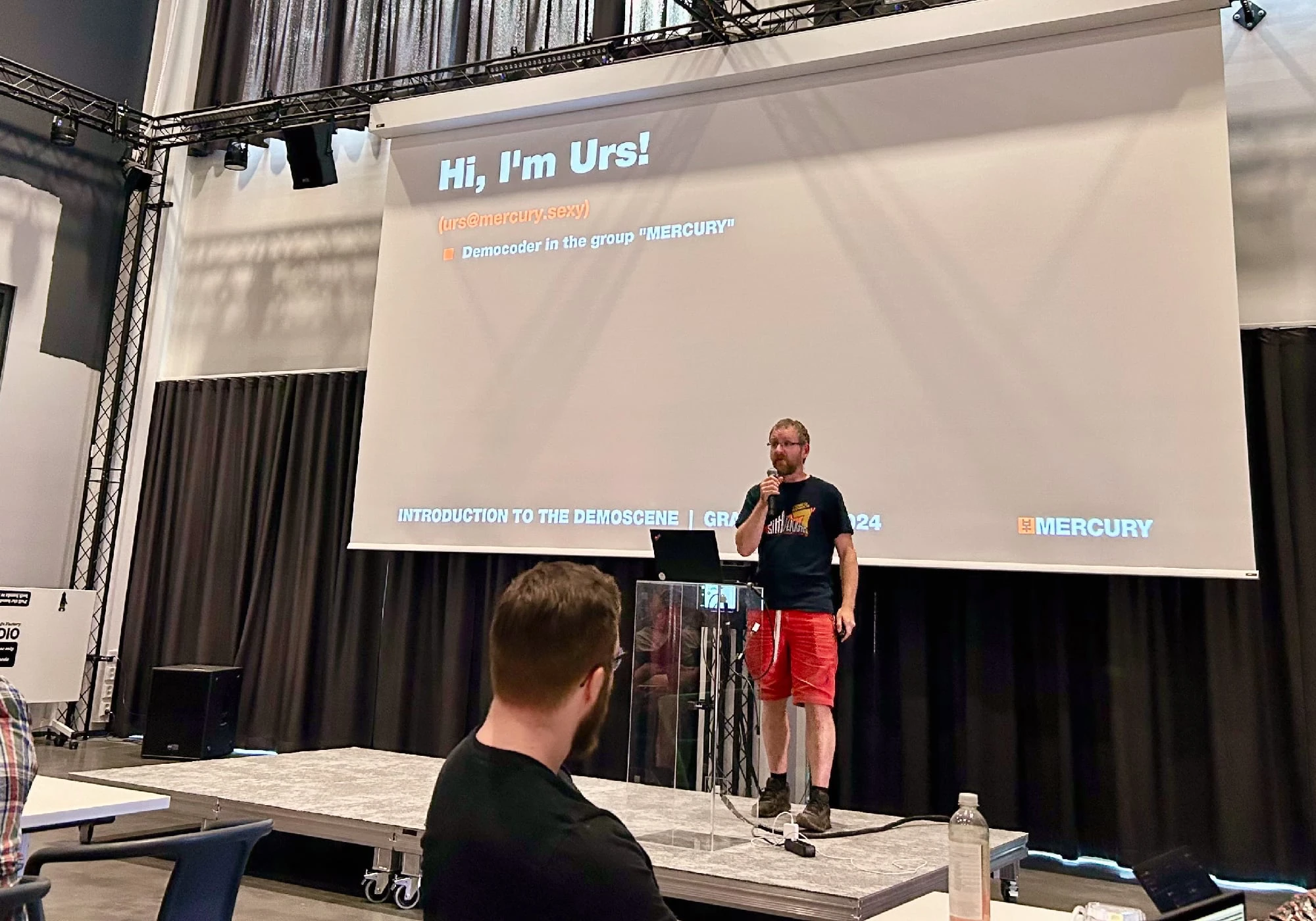
The introduction to the demoscene by the scener Urs.
This was followed again by Felix, who introduced some of the essential tools for creating demos, such as the open-source framework Processing and it's web cousin P5js. He made the materials available online for reference. This session offered a quick start guide and an opportunity for participants to ask questions. He also laid down the rules of the event, the code of conduct, and the strict anti-harassment policy.
At this stage, I started a conversation with two folks at my table. It turned out that they were Anni and Jaron, the organizers of another demoparty called Alt Party.
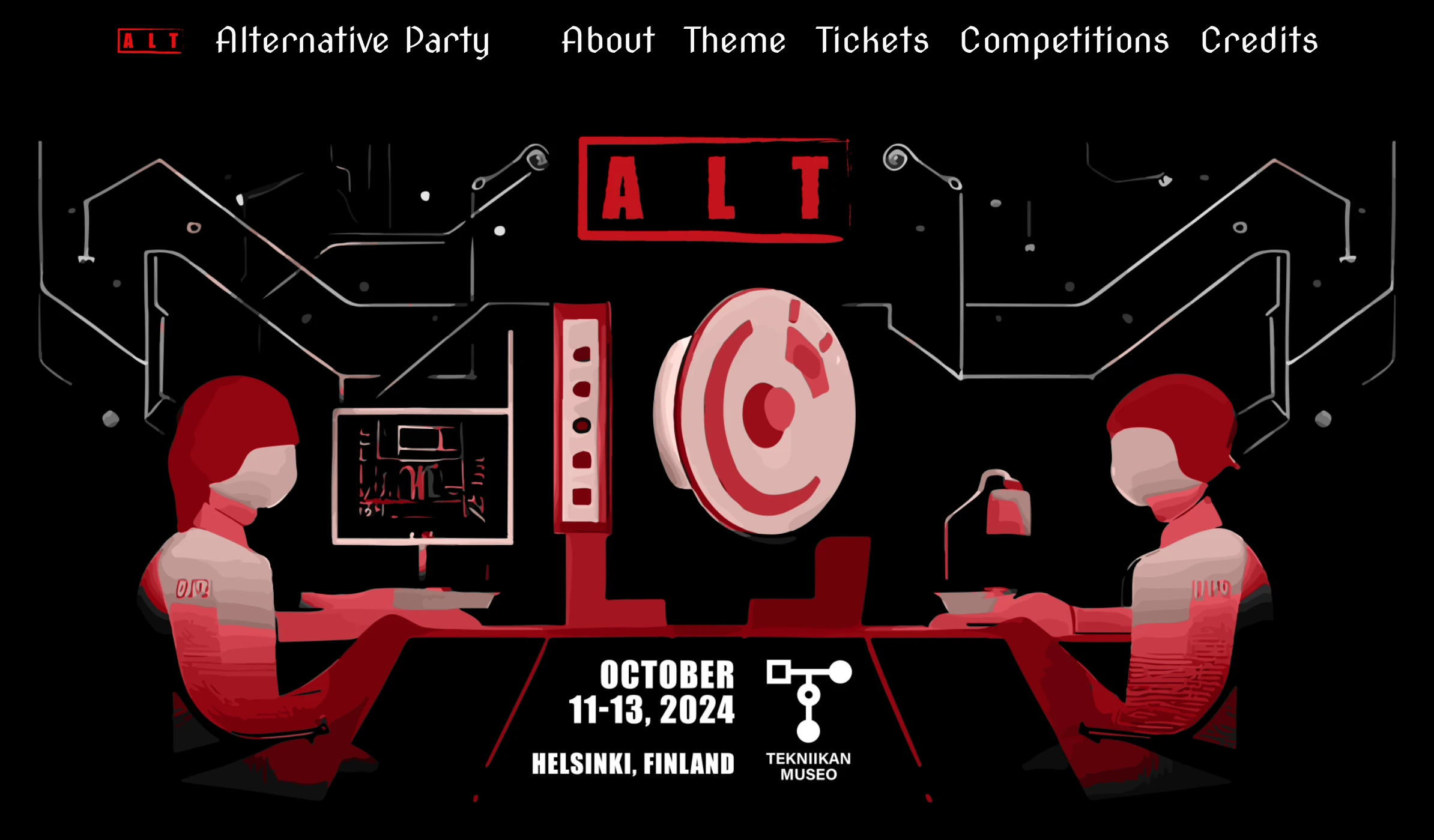
The website of the AltParty at
altparty.org
They showed me some of the tools they used for their music visualization (the visual development tool Touch Designer and the motion design tool Notch). Their work is amazing. At one of the nighttime events they showed a video of, their visuals were projected on the side of two buildings. Impressive stuff!
They told me how challenging it was to adapt the visuals to the ever-shifting beats per minute of the music that the DJs play. Jaron and Anni plugged their Alt Party at Graffathon but unfortunately had to leave.
Together with the other participants, I dove into the core activity of the event: creating a demo. I decided to use the Processing framework with Java as the language (you can also use Python to program Processing). It is an open-source graphical library and integrated development environment built for the electronic arts, new media art, and visual design communities. Processing was designed to make coding accessible to artists, designers, and beginners through a simplified Java-based language. Processing supports creating interactive graphics, animations, and visualizations, making it ideal for the demoscene.
Other folks used P5js, game-development toolks like RayLib and Unity as well as many other tools and frameworks. Some participants even used Roblox and pure shader coding. Everyone was encouraged to add music to their demos. While some participants wrote their own music, like me most folks used music tracks from royalty-free collections like incompetech.com.
We were free to leave earlier, but most of us stayed on, working hard on our demos. The venue officially closed at 23:00, concluding the first day of Graffathon 2024. When I left the building to catch the metro back to Helsinki, I was surprised by how light it still was. It was close to midnight, but it felt more like 6 pm in countries further south. This "Midnight Sun" would take some getting used to.
Second Day: At the Quiet Place
On the second day, the official start was at 9 am. Many participants opted to stay home to work on their demos remotely. With a slightly bad conscience, I arrived at 10:30 and continued work on my Processing demo. Other participants also returned to continue their work. The entire day was dedicated to demo creation, allowing us to collaborate, innovate, and refine our projects. Flexibility was key, as attendees could come and go as needed, coordinating with their teams.
We frequently collaborated, combining our diverse skills and perspectives to tackle programming problems and artistic dead ends. This cooperative environment allowed us to brainstorm ideas, share knowledge, and find innovative solutions more efficiently than working alone.
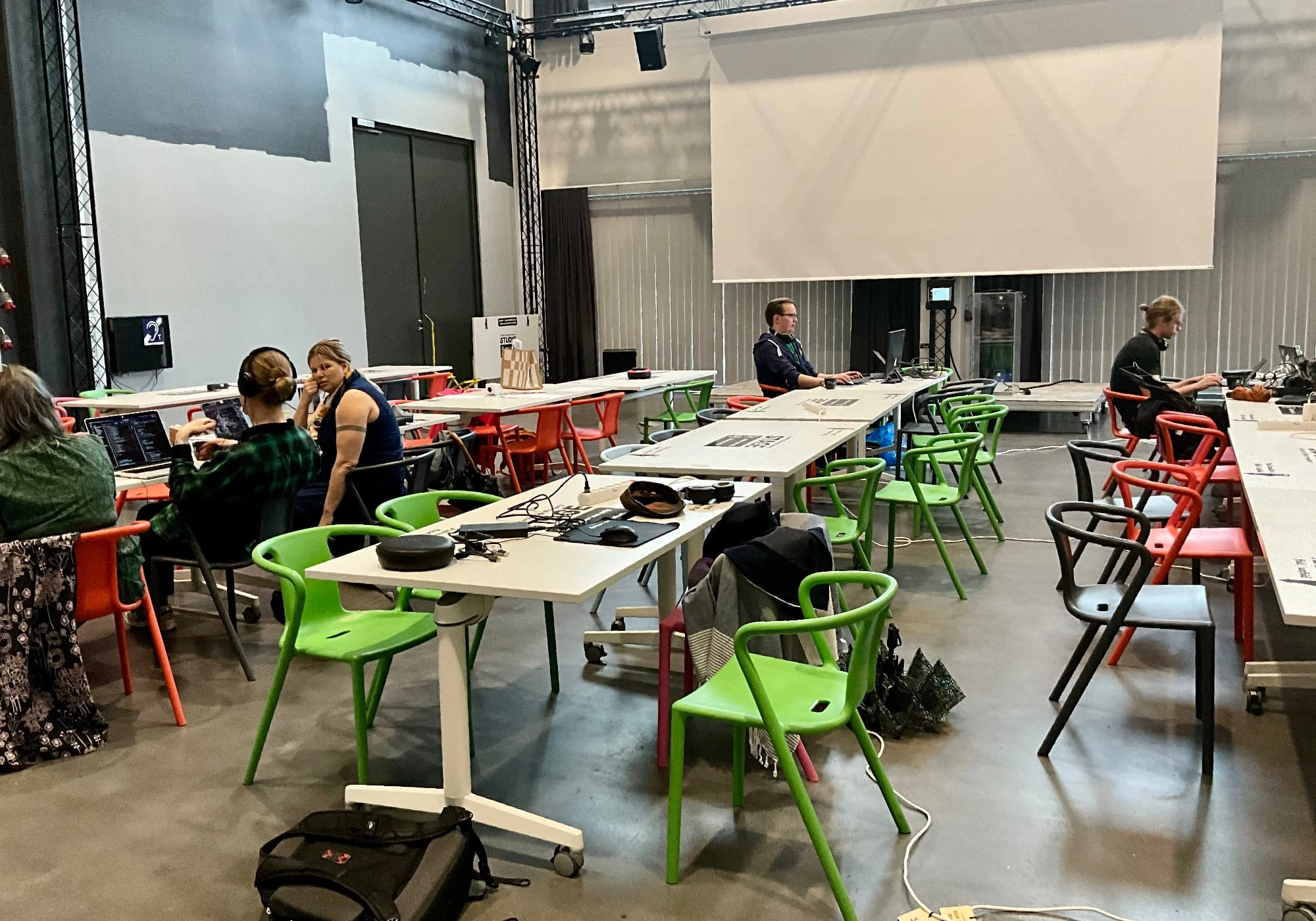
On Saturday, everyone in the main event hall was working on
programming their demo. It was quieter than in the movie 'A
Quiet Place'.
The organizers were also readily available as expert tutors throughout the event, offering their expertise and support. We approached them with specific coding issues or artistic challenges, receiving personalized advice and mentorship. This guidance helped demystify complex problems and provided new directions for creative exploration.
Of course, we also made use of the wealth of online resources, tools, and references. I feel that sometimes solving a problem by myself without consulting anyone helps me learn and develop.
It struck me how quiet it was during the event. Unlike other demoparties, there was no pounding techno music. Additionally, the room was well-lit and clean.
Graffathon is first and foremost an in-person event. This does not mean that remote-only participants weren't permitted to join. There were a few who joined the Telegram channel and tuned in through the livestream to watch the competitions. I think that even one of the winning submissions was from a remote participant. The big disadvantage of joining remotely is that remote participants do not benefit from the tutoring during the event. Some of them reached out on Telegram to get some tips, but most worked everything out themselves.
We all focused on our programming challenges and toiled away on our demos. I found it exceptionally liberating that I did not need to adhere to guidelines or document my code. I was in a programming trance, keeping all the information alive in my head. Working on my demo made programming fun again!
But alas, just like the previous day, the venue closed at 23:00. We had to wrap up our work for the day and head home. What a day it had been!
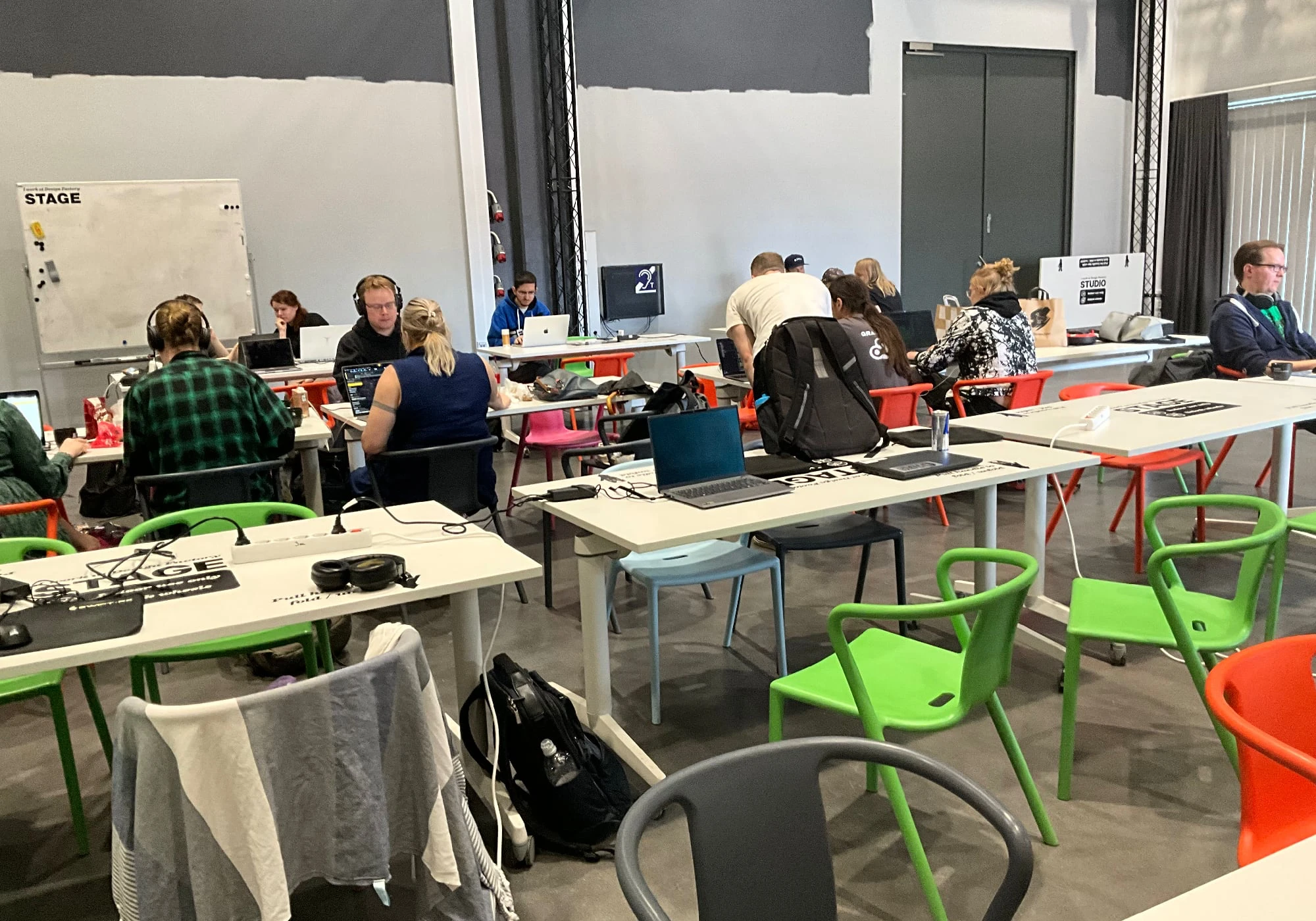
Hard at work on the demo. Graffathon is probably the quietest
demoparty ever.
The Aalto Design Factory
It wasn't all programming and work on the second day. I also used the opportunity to explore the Aalto Design Factory. It was Saturday, so apart from the demoparty participants, there were very few people here.
The Design Factory is like a cross between a fun house and a workshop. The interior design is playful and friendly, yet still utilitarian, with work tables in the common areas, a nice dining room with a practical kitchen, and the large industrial design studio with tools and workbenches as the "crown jewels." There are even a pair of table football tables and a table tennis table available in the common area (I guess here at Aalto they like recreational equipment that has the word "table" twice in its name).
As the name suggests, the Aalto Design Factory is a multidisciplinary hub for design and innovation. It is part of Aalto University, located in Espoo, Finland. It provides a collaborative environment where students, researchers, and industry professionals come together to work on creative projects and develop new ideas. The facility offers state-of-the-art tools and resources for prototyping, experimentation, and product development, fostering a culture of interdisciplinary learning and entrepreneurial thinking. The Aalto Design Factory is known for its emphasis on hands-on, practical approaches to solving real-world problems.
Below are some impressions from my little exploratory tour.
Third Day: Finishing and Submitting the Demos
The final day also started early. We put the finishing touches on our demos, as this was the last stretch before the submission deadline. There were a few minor quirks when we submitted our work. The compo machine was a PC running Linux, and at first, it didn't play any sound. However, that was fixed with a quick reboot. Even though the machine ran Linux, it had no trouble with Windows executables thanks to Proton or a similar compatibility layer.
After we had submitted our work, the organizers took about an hour to verify that all entries were functioning correctly. There were still some quick fixes, but then all the submissions were verified.
Advanced Category Submissions
This category included five submissions, highlighting the work of more experienced participants who pushed the boundaries of what's possible in the demoscene. This is a playlist of all the videos of the Advanced compo
(Click on the playlist icon in the top right to see the whole playlist of the Advanced submissions).
Beginners Category Submissions
This category featured twelve entries, showcasing the creativity and skill of newcomers to the demoscene. This is a playlist of all the videos of the Beginners compo.
(Click on the playlist icon in the top right to see the whole playlist of the Beginners submissions).
The highlight of the event, the Demo Compos, featured all submitted demos displayed on a big screen. We rated the demos in two categories: advanced and beginner, culminating in an exciting points-based competition.
Here are some photo impressions of the compo viewing.
This weekend the EU parliamentary elections were held all over Europe. This was not the only voting... we got the opportunity to vote for the competion entries.
This voting at Graffathon is an integral part of the event, fostering a sense of friendly competition among participants. We used a voting system hosted on party.graffathon.org.
The voting process was not too different from other demoparties like Revision and Evoke. It was meticulously organized to ensure that every demo received the attention and consideration it deserved.

These were all the demos submitted to the categories in the
demo party's voting system.
The use of a dedicated voting platform not only streamlined the voting process but also enhanced the overall experience for participants and spectators alike. By celebrating both novice and advanced entries, Graffathon 2024 fostered an inclusive and inspiring environment where creativity and technical skill were equally valued and recognized.
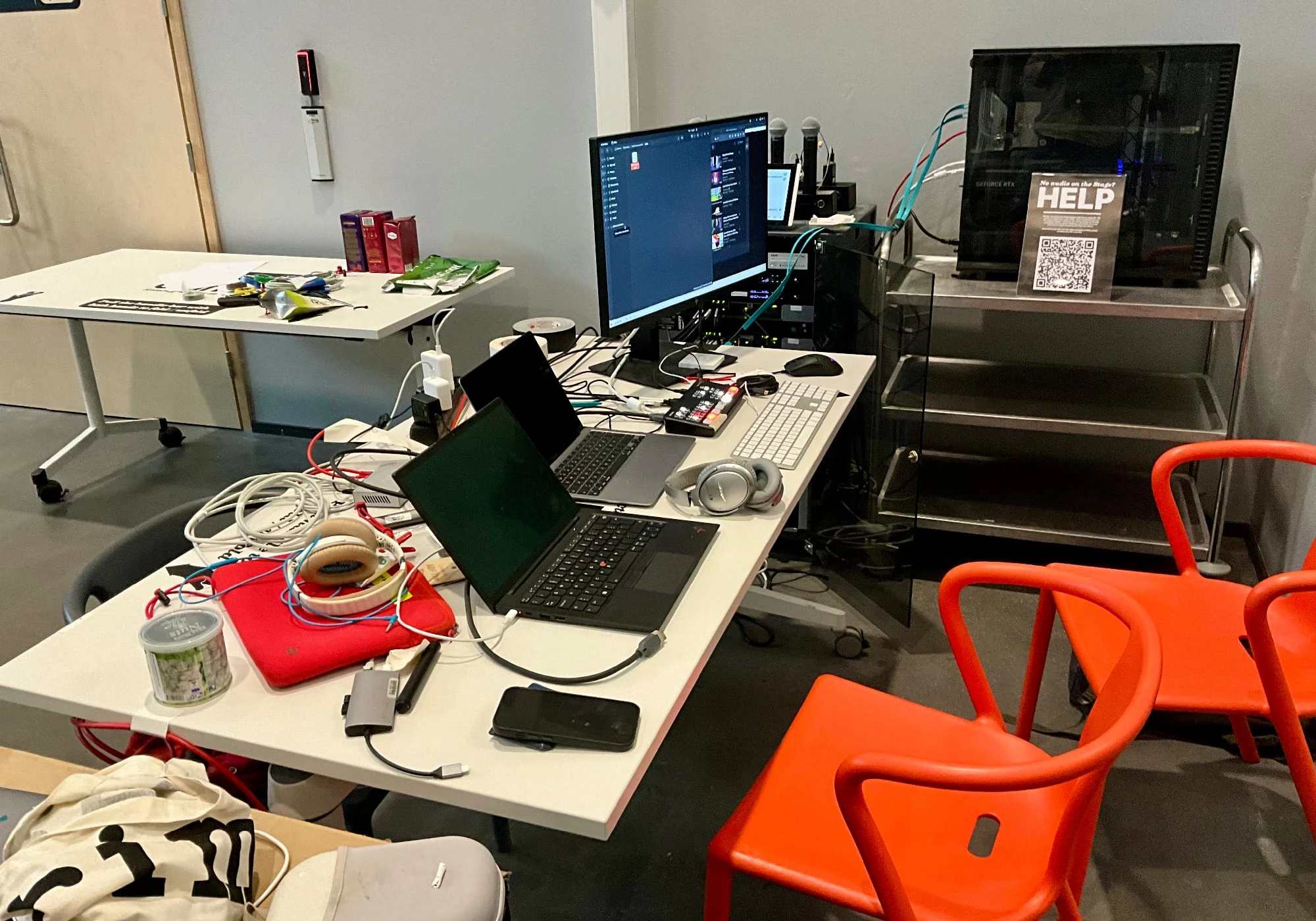
The competitions PC was a Linux machine. At first it was a
bit excentric with the sound playback but the organizers
coerced it into cooperation.
Competition Submissions and Results
The winners were announced and celebrated during the awards ceremony. The closing remarks included insights on future events and activities, encouraging continued involvement in the demoscene community. Please find the results below and on the official Demozoo entry for Graffathon 2024.
Results of the Advanced Category |
||
|---|---|---|
| 1. | Twos complement by as graffa bois | 120 points |
| 2. | Splines, sdfs and a synthdef by rokas | 116 points |
| 3. | Sun-kissed garden by Teemu | 99 points |
| 4. | Floating Point by Magnetismin Tietokonekerho | 95 points |
| 5. | Kirsikankukka ja kurikan kuu by papu^Magnetismin Tietokonekerho | 73 points |
Results of the Beginners Category |
||
|---|---|---|
| 1. | We are doing ARt by bukomp40 | 137 points |
| 2. | CATRO by Veikko & Valiobeats | 135 points |
| 3. | Box Assert by Sam Westerlund | 112 points |
| 4. | cottage cheese by SuperRuusu | 101 points |
| 5. | My First Demo by Ville S | 96 points |
| 6. | projectWHERE by Shamit Ahmed | 89 points |
| 7. Shared place | Forest for the Trees by Team Forest | 86 points |
| modulated_space by greenhouse | 86 points | |
| 9. | Virman bileet goes Avaruus by vaDOD | 74 points |
| 10. Shared place | Light of Discernment by appas | 73 points |
| GLITCH EPILEPSÍ by Bala-Koala - That's me! | 73 points | |
| 12. | 3 of Darkness by Archit3ch + Arka | 61 points |
Closing Ceremony and Looking Ahead
As Graffathon 2024 drew to a close, the atmosphere at the Aalto Design Factory was filled with excitement. The final hours of the event were dedicated to celebrating the participants' hard work and creativity.
The anticipation culminated in the awards ceremony, where the best demos in both the Beginners and Advanced categories were recognized. Winners received accolades not only for their technical prowess but also for their artistic ingenuity and the impact of their creations. The teams or individuals who won the first place in one of the two categories received a ticket to Assembly. All other winners got a fine-looking certificate as a memento.
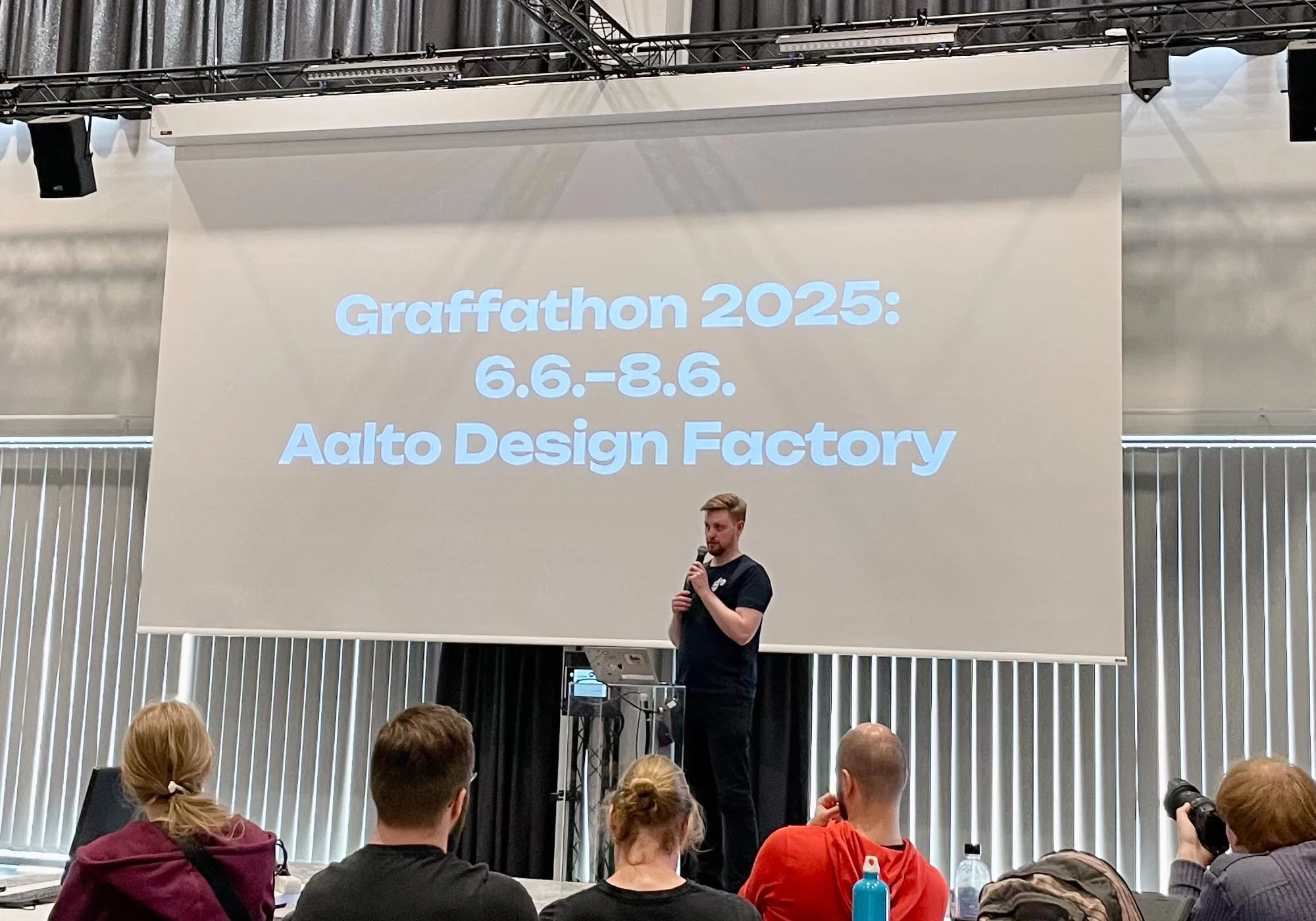
Felix Bade from the organizer team took to the stage to
announce that the
next Graffathon was planned for June 6 to 8, 2025.
The event concluded with a heartfelt closing ceremony. Organizers reflected on the journey over the past three days, highlighting the collaboration, innovation, and community spirit that defined Graffathon 2024. Attendees were encouraged to stay connected and continue exploring the demoscene culture.
With the success of this year's event, the organizers were thrilled to announce the dates for Graffathon 2025 on June 6 to 8, 2025. Promising even more opportunities for creativity and collaboration, the next event is already generating excitement within the community.
For me, Graffathon 2024 was a wonderful event demonstrating the power of combining technology and art, bringing together a diverse group of individuals united by their passion for creation!
I'd like to thank the organizers at Digital Media Club Aalto University and the Aalto Design Factory for their hard work in making Graffathon 2024 a reality. I'd also like to express my utmost admiration to the participants for their creativity, dedication, and camaraderie. It was an unforgettable experience, and I look forward to seeing what the future holds for Graffathon and the demoscene community.
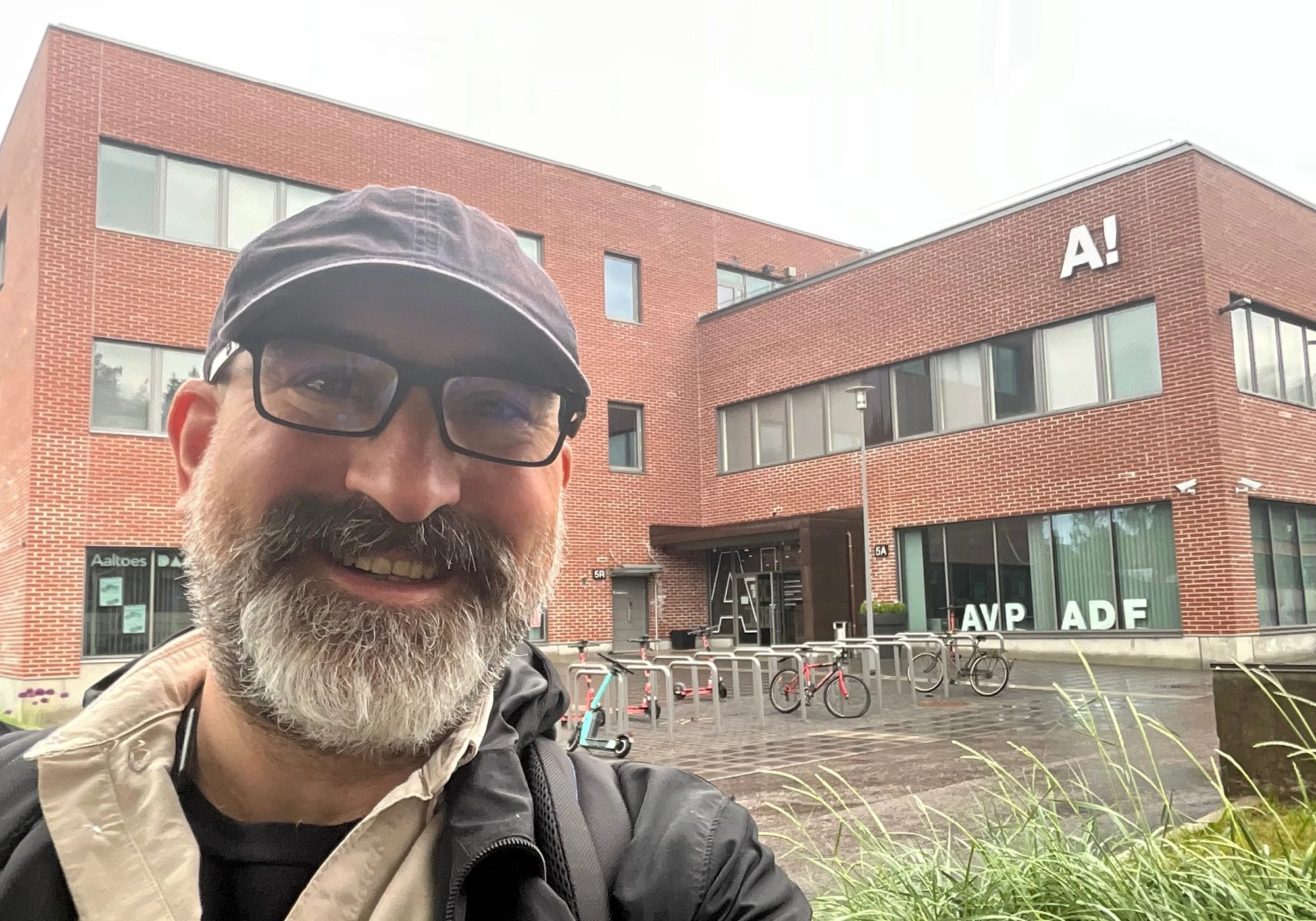
Leaving the Aalto Design Factory after Graffathon 2024.
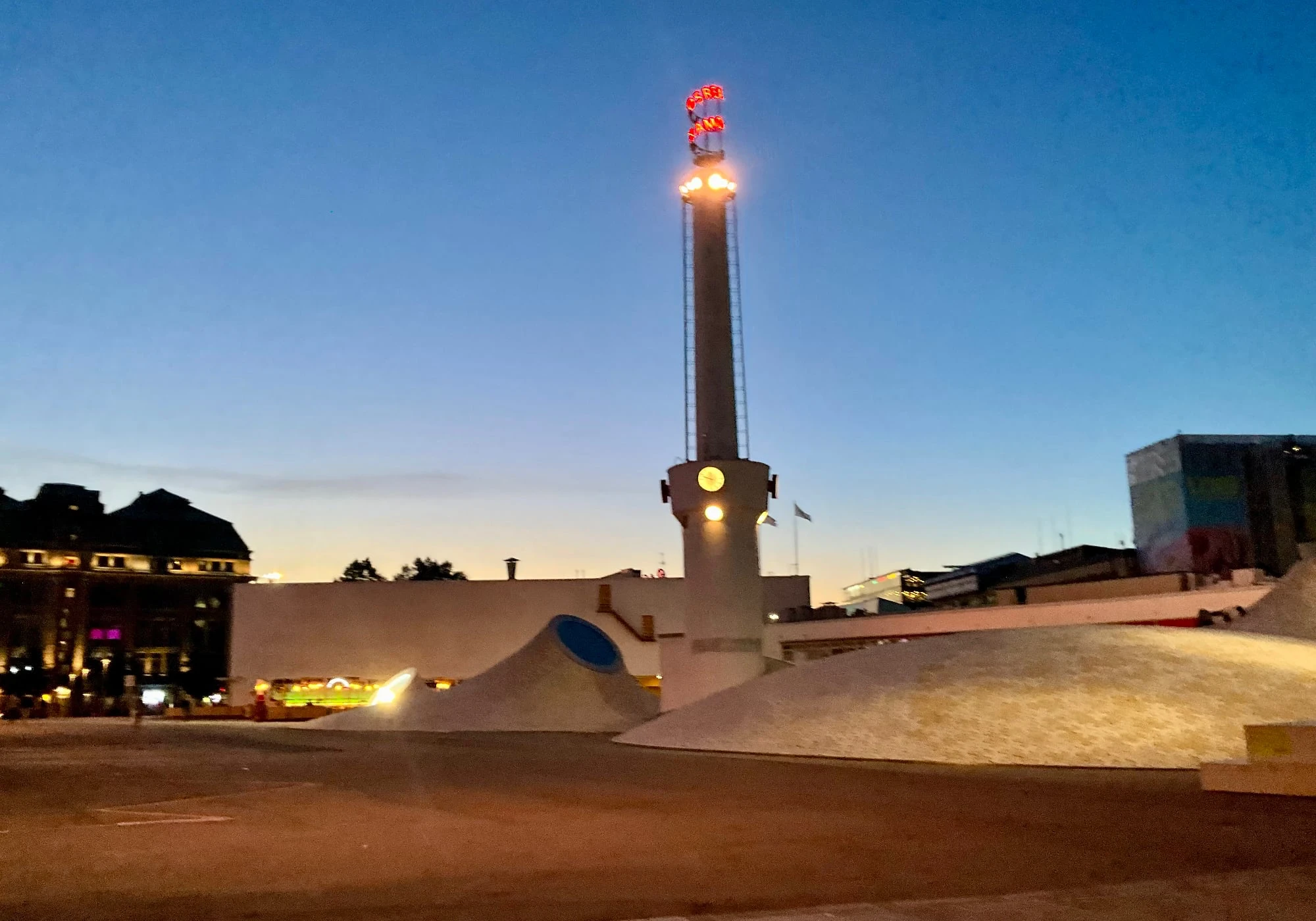
The Kamppi area in Helsinki ten minutes before midnight: the
horizon was illuminated by the baffling "Midnight Sun".
My Little Demo
This was actually the first full demo release I submitted at a demoparty (in the past demoparties, I only participated in the graphics compos).
Even though I had a lot of fun making it and it really opened up my mind to keep working with Processing, I do admit, my demo just sucks and that some of the effects do things that I did not expect 🤣 It is terrible and no-one should sit through this. But it is my kind of terrible. I certainly learned a lot from it. So now I can work on a cool submission for another demoparty (perhaps Evoke 2024 in August).
The result of the voting is evidence enough. I share the second to last place in the Beginners category together with another demo. But it is a start! I will make more and hopefully better demos.
My Processing code can be found here in the GitHub repository: github.com/mbalabanov/graffathon_2024
Video capture of GLITCH EPILEPSÍ | Bala-Koala (direct link to Youtube)
